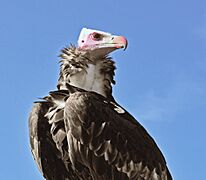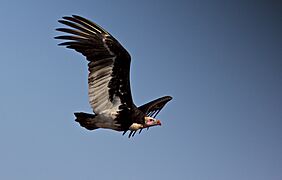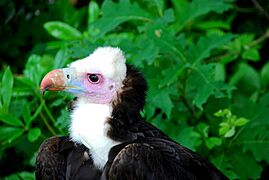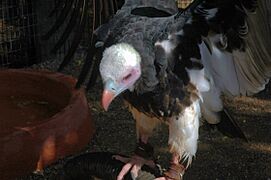White-headed vulture facts for kids
Quick facts for kids White-headed vulture |
|
|---|---|
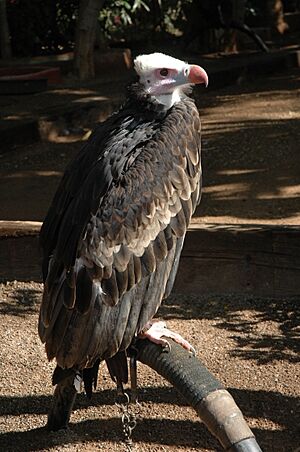 |
|
| At Las Águilas Jungle Park, Tenerife, Spain | |
| Conservation status | |
| Scientific classification | |
| Genus: |
Trigonoceps
|
| Species: |
occipitalis
|
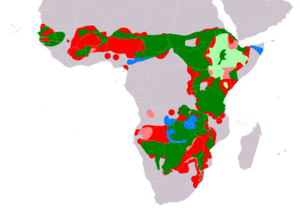 |
|
| Range of T. occipitalis Resident Possibly Extant (resident) Non-breeding Probably extinct Extinct | |
The white-headed vulture (Trigonoceps occipitalis) is a special type of Old World vulture. It lives only in Africa. Sadly, the number of these vultures has dropped a lot recently. This is because their homes are being destroyed. Also, vultures are often poisoned when they eat dead animals. Long ago, a relative of this vulture lived on an island called Flores in Indonesia. This shows that these birds used to live in more places.
Contents
What Does the White-Headed Vulture Look Like?
The white-headed vulture is a medium-sized bird. It is about 72 to 85 centimeters (28 to 33 inches) long. Its wings can spread out very wide, from 207 to 230 centimeters (81 to 91 inches). Female vultures are usually a bit heavier than males. Females weigh about 4.7 kilograms (10.4 pounds). Males are lighter, weighing 4 kilograms (8.8 pounds) or less. This is unusual for African vultures, as females are often bigger.
This vulture has a pink beak and a white feathery crest on its head. The skin on its head, where there are no feathers, is very pale. Its upper body is dark brown, and its tail feathers are black. The feathers on its lower body and legs are white. This white color helps identify it when it flies overhead. These vultures are easy to spot because their black and white feathers stand out. Each white-headed vulture also has a unique pattern on its wings. This helps people tell them apart.
Where Do White-Headed Vultures Live?
White-headed vultures live across a large part of sub-Saharan Africa. This area stretches from Senegal and Gambia in the west to Somalia in the east. It goes south to South Africa and Eswatini. They are not very common in most places. Scientists once thought there were about 10,500 to 18,750 of these birds. But newer counts show there might be only 5,500 left.
Many white-headed vulture nests are found in protected areas. About 1,893 nests are in 400 protected places. Most of these are in East Africa, Central Africa, and Southern Africa. They like to live in dry woodlands that are not too high up. In Ethiopia, they can be found up to 4,000 meters (13,000 feet) high. In Kenya, they might be found up to 3,000 meters (9,800 feet). They also live in thorny Acacia tree areas in Botswana. These vultures usually stay away from people. They prefer to live in protected areas. For example, Kruger National Park in South Africa has the largest group of these vultures.
Life and Habits of the White-Headed Vulture
White-headed vultures live for a long time. They seem to stay in the same area their whole lives. They build their nests in tall trees, often Acacia or baobab trees. They especially like Senegalia trees. Their nests are usually at the very top of the tree canopy. These vultures usually lay just one egg. They do this a few months after the rainy season ends.
They are usually solitary birds. This means they nest alone, often in pairs. One study looked at 73 pairs of vultures. It found that about 0.69 chicks were born per pair. White-headed vultures have interesting breeding habits. In Kruger National Park, mating only happens on the nest. It is a quiet process that lasts about 15 to 20 seconds. The female stands in front of the male. They make a deep squeaking sound during this time.
White-headed vultures mostly eat carrion, which is dead animals. They often fly lower than other vultures. This means they are usually the first to find a dead animal. But they can also hunt live prey. They have been seen catching animals like the slender mongoose, monitor lizards, tree squirrels, and scrub hares. In some cases, two vultures worked together to hunt. This suggests they might hunt more often than we think. More research is needed to understand this fully.
Their eyesight is also special. It is more like a hawk's vision than other vultures. They have a wider field of vision, about 30 degrees. Other vultures like Gyps vultures only have about 20 degrees. This wider vision helps them aim their claws better when catching live prey.
Why White-Headed Vultures Need Our Help
The number of white-headed vultures has been going down since the 1940s. In 2007, they were listed as a vulnerable species. But by 2015, they were listed as Critically Endangered. This means they are in great danger of disappearing forever.
The main reasons for their decline are:
- Less Food: There are fewer dead animals for them to eat. This includes medium-sized mammals and hoofed animals.
- Loss of Home: Their natural homes are being lost. This is because cities and farms are growing.
- Poisoning: This is a big problem. Sometimes, poison is set out for other animals like jackals or hyenas. Vultures eat these poisoned baits and die. Poachers also poison vultures on purpose. They do this to stop the birds from circling above dead animals. Vultures circling can alert park rangers to illegal hunting.
- Other Threats: Some vultures are caught and sold in the international trade. Others are used in traditional medicines.
These vultures are very sensitive to changes in their environment. They tend to leave areas where their habitat is damaged. This is why many of them are now found only in protected areas. A medicine called Diclofenac is also a future worry. This drug is given to farm animals. If vultures eat the meat of animals treated with Diclofenac, it can kill them. This drug has already harmed other vulture species.
In June 2019, a terrible event happened in northern Botswana. The bodies of 537 vultures were found. This included 17 white-headed vultures. Many other types of vultures and two tawny eagles also died. It is thought they died after eating three elephants that poachers had poisoned. The poachers likely did this to hide their illegal hunting.
-
Flying in Kruger National Park, South Africa



